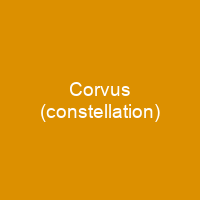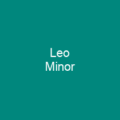Corvus is a small constellation in the Southern Celestial Hemisphere. The four brightest stars, Gamma, Delta, Epsilon, and Beta Corvi, form a distinctive quadrilateral in the night sky. It is bordered by Virgo to the north and east, Hydra to the south, Crater to the west and three-letter abbreviation for Crater.
About Corvus (constellation) in brief

The name means “crow” in Latin, and it is one of the 48 constellation listed by the 2nd-century astronomer Ptolemy. It depicts a raven, a bird associated with stories about the god Apollo, perched on the back of Hydra the water snake. The Babylonian constellation was sacred to Adad, the god of rain and storm; in the second Millennium it would have risen just before the autumnal rainy season. With an apparent magnitude of 2. 59, Gamma Corvi—also known as Gienah—is the brightest star in the constellation. It is an aging blue giant around four times as massive as the Sun. The young star Eta Corvi has been found to have two debris disks, Three star system has exoplanet, TV Corvi is a dwarf nova—a white dwarf and brown dwarf in very close orbit. In Chinese astronomy, the four main stars depict a chariot, Zhen, which is the 28th and final lunar mansion; Alpha and Eta mark the linchpins for the wheels, and Zeta is Changsha, a coffin. In Indian astronomy, the five main stars of CorvUS represent a hand or fist corresponding to the Hasta, the 13th nakshatra or lunar mansion. The constellation is associated with the myth of Apollo and his lover Coronis the Lapith.
You want to know more about Corvus (constellation)?
This page is based on the article Corvus (constellation) published in Wikipedia (as of Nov. 04, 2020) and was automatically summarized using artificial intelligence.







